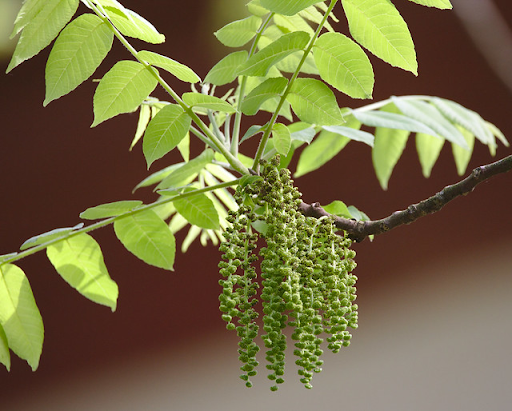Native Plant Profile: Black Walnut (Juglans nigra)
Black walnut (Juglans nigra) is a stately tree with an oval to round crown that looks great in front yards. It is part of the walnut family (Juglandaceae) which also includes pecans and hickories. It has long been used for food, dye, and as a highly prized wood source.
Black walnut can grow 75-100 feet tall and can have a similarly sized spread. It has compound leaves that have 9-21 long, pointed leaflets with finely toothed margins. The leaves slightly resemble the leaves of the invasive Tree of Heaven (Ailanthus altissima). Tree of Heaven leaves have coarse teeth at the base of the leaflets and have a distinct burnt peanut butter smell when the leaves are broken. Black Walnut has a distinctive leaf scar that is often described as a “monkey face.” The rare butternut can have a similar leaf scar, the “monkey face” has hairy eyebrows. Black walnut has dark, furrowed bark. It is late to leaf out in the spring and drops its leaves early in the fall, so some people do not like to have it in their yards. Nevertheless, it is an excellent wildlife tree.
Black walnut flowers May through June. The male flowers are yellow-green catkins that droop from the tree while the female flowers are in spikes. Trees will contain both male and female flowers and are capable of self fertilization. However, this tree is primarily wind pollinated. Black walnuts can produce nuts in as little as 4-6 years but most trees take up to 20 years to produce the characteristic black walnuts. The nuts have a spicy scent and a green husk surrounding a tough brownish-black husk. The large, hard walnuts can be a hazard when they drop, so do not plant black walnut near sidewalks, driveways, or areas where people may congregate. A falling walnut will never be forgotten.
Black walnut grows best in full sun. It does not tolerate shade well, though some of the younger trees can get by with part sun for a couple of years. It likes to grow in moist, well-drained soil. Black walnut is well known for being allelopathic, producing a compound known as juglone which it releases into the soil around its roots. Juglone inhibits some plants from growing around the walnut, reducing potential competition. However, species such as maple (Acer), birch (Betula), and beech (Fagus) have shown some resistance to the compound. For additional juglone-resistant plants, see “Landscaping and Gardening Around Walnuts and Other Juglone Producing Plants” on the PennState Extension website.
Black walnut is a host plants for over 100 species of butterflies and moths including the Luna Moth, Regal Moth, Imperial Moth, Walnut Sphinx Moth, Fall Webworm Moth, Walnut Caloptilia, Pecan Leafminer Moth, Monkey Slug Moth, and more! The walnut it produces is edible but hard to access from the tough husk on the outside. Nevertheless, wildlife like flying squirrels will enjoy the delicious nut. The high concentration of fatty acids in the walnut make it an excellent fall snack to gear up for winter.
References:
Williams, R. D. 2021. Juglans nigra L. (https://www.srs.fs.usda.gov/pubs/misc/ag_654/volume_2/juglans/nigra.htm). Accessed June 28, 2021.
Happy Summer HabiChat fans!
Wow! What an emergence for Brood X! While I enjoyed the periodical cicadas for the most part, I am happy to have a bit of reprieve from the noise.
In addition to Brood X, we also have been receiving reports of sick birds around the region. Since the initial reports in May, the reports have come in from Maryland, Washington, D.C., Virginia, Pennsylvania, Ohio, and Kentucky. At this time, not much is known and we are suggesting people temporarily cease feeding birds until more is known about the causative agent and how it spreads. Please see the USGS Interagency statement for more information. For Maryland residents, if you encounter sick or dead birds, please contact the DNR/USDA Wildlife Services hotline (877-463-6497) or (410-349-8130) for those with numbers outside of Maryland. If you must remove dead birds, place them in a sealable plastic bag to dispose of with household trash. Additional information will be shared as diagnostic results are received.
This issue is a bit bittersweet. After almost ten years of writing for HabiChat and running the Wild Acres program, I will be heading out to work on new initiatives. I have very much enjoyed working with backyard wildlife habitat enthusiasts across Maryland and hope you continue to work on creating wildlife friendly spaces! The Wild Acres program and HabiChat newsletter will still be available.
In this summer issue, learn a little more about the beautiful and often overlooked rosy maple moth as well as other royal silkworms in Maryland. In addition, black walnut is our native plant featured this month. This species supports several species of royal silkworm moths as well as more than 100 other butterfly and moth species. With the summer heat and rains, our wild turtles are also on the move, so you can read about how to give local box turtles a boost in your backyard.
Happy Habitats,
Kerry Wixted
Click here to have HabiChat—the quarterly backyard wildlife habitat newsletter from the Wild Acres program—delivered right to your inbox!
In this Issue
- Native Animal Profile: Rosy Maple Moths
- Habitat Tips: Supporting Royal Silkworm Moths in Maryland
- Habitat Tips: In Our Hands: Giving Local Box Turtles a Boost




 1-888-373-7888
1-888-373-7888 233733
233733